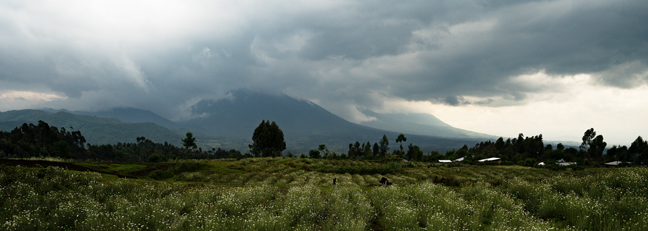

Volcanoes Nyungwe Forest National Parks, Rwanda, December 2019
I rarely get to Africa anymore, although it was an important and always welcome part of my academic life. I taught in Eritrea and South Africa in between the various conflicts, produced dozens of Special Olympics stories across the Continent, half a dozen major student documentary projects and had the privilege of photographing its peoples and animals in more than a dozen countries. Now it is too expensive and too long and difficult a trip. Most of my colleagues from the region have moved on or retired, frustrated with the corruption, low wages, political instability, crime and loss of academic freedoms.
The free-roaming wildlife populations are greatly decreased, and access has been greatly restricted except for wealthy international tourists. Decades ago, we stayed in local villages or bush camps, not at luxury safari camps. We hired local guides who lived their lives in harmony and conflict with the animals and there were no fences or borders preventing great migrations. It was a different time, not necessarily better or worse, just different. It seemed so much more romantic, although it probably wasn’t.
The land mass of Africa is more than 75 percent larger than the United States, is made up of more than 50 countries and is home to more than 1/3 of the Earth’s human inhabitants, so I never knew Africa. I just experienced small vignettes over three decades, avoided the most serious genocides and conflicts and stayed as apolitical as possible. The most I accomplished was sharing it with some of my students. It changed many of them and they are better people and journalists for the experience.
I grew up in Chicago and although Bushman died before I was born, we often saw his remains during childhood trips to the Field Museum. He was a lowland gorilla and the most famous zoo animal in the world during the 1930s and 40s until his death in 1951 at Lincoln Park Zoo, less than 15 miles from my childhood home. Even in those days, there was not a lot of wildlife in the Chicagoland area outside of Lincoln Park and Brookfield Zoos and I had no concept of what a zoo really was. To me, they were just magical places filled with mysterious animals. Other than Mutual of Omaha’s Wild Kingdom, one of the first television shows I remember watching, it was an era long before nature documentaries. Animals lived in zoos and it took me almost 60 years before I would sit with a gorilla in the wild. It was worth the wait.
©Rich Beckman
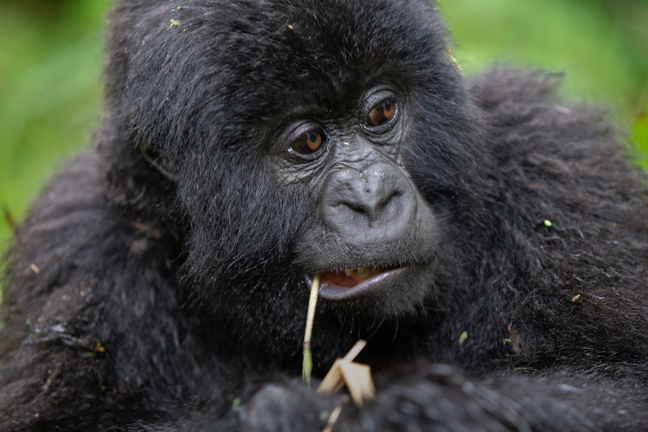

Volcanoes National Park, Ruhergeri, Rwanda, December 2019
We spent our first three mornings in Volcanoes National Park in Ruhergeri, Rwanda. The first with the Muhoza Family of Mountain Gorillas, the newest group in the Park. It was formed by Muhoza, the dominant Silverback on December 3, 2016, when he grabbed two females from the Hirwa Family Group. He is the youngest dominant Silverback in the Park and one of the largest, weighing more than 460 pounds.
We spent the second morning with Golden Monkeys, the other endangered primate in the Park. There are less than 3,000 Golden Monkeys left in the Park and their populations continue to dwindle.
We spent the third morning with the Agash Family Group of Mountain Gorillas. The group has been together under his leadership since 2010 and is comprised of more than 25 members, including three other Silverbacks, six adult females, four immature male blackbacks, two sub-adult females, three juveniles and six infants.
All of the treks in Park are held in the early morning and are limited to a one-hour interaction. Each gorilla group is visited no more than once per day with each group limited to eight tourists, guides, trackers and porters.
Whereas Golden Monkeys are often high in the trees, interactions with Mountain Gorillas are personal and often within a few yards as they are habituated and often pass in close proximity. At times, you have to quickly move out of the way. They are imposing, though not frightening and difficult to photograph.
There is limited light due to the heavy jungle cover and their deep inset brown eyes rarely capture the light, an essential ingredient for successful Mountain Gorilla photographs. There are also seven other tourists trying to take pictures and many pushing the limits to get effective iPhone images.
©Rich Beckman
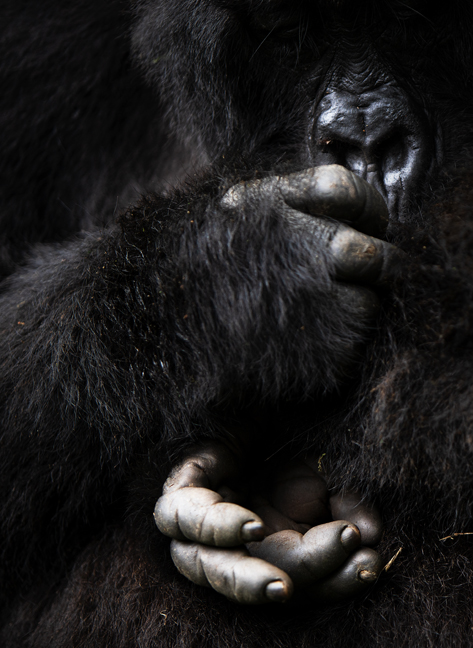

Volcanoes National Park, Ruhergeri, Rwanda, December 2019
We spent our first three mornings in Volcanoes National Park in Ruhergeri, Rwanda. The first with the Muhoza Family of Mountain Gorillas, the newest group in the Park. It was formed by Muhoza, the dominant Silverback on December 3, 2016, when he grabbed two females from the Hirwa Family Group. He is the youngest dominant Silverback in the Park and one of the largest, weighing more than 460 pounds.
We spent the second morning with Golden Monkeys, the other endangered primate in the Park. There are less than 3,000 Golden Monkeys left in the Park and their populations continue to dwindle.
We spent the third morning with the Agash Family Group of Mountain Gorillas. The group has been together under his leadership since 2010 and is comprised of more than 25 members, including three other Silverbacks, six adult females, four immature male blackbacks, two sub-adult females, three juveniles and six infants.
All of the treks in Park are held in the early morning and are limited to a one-hour interaction. Each gorilla group is visited no more than once per day with each group limited to eight tourists, guides, trackers and porters.
Whereas Golden Monkeys are often high in the trees, interactions with Mountain Gorillas are personal and often within a few yards as they are habituated and often pass in close proximity. At times, you have to quickly move out of the way. They are imposing, though not frightening and difficult to photograph.
There is limited light due to the heavy jungle cover and their deep inset brown eyes rarely capture the light, an essential ingredient for successful Mountain Gorilla photographs. There are also seven other tourists trying to take pictures and many pushing the limits to get effective iPhone images.
©Rich Beckman
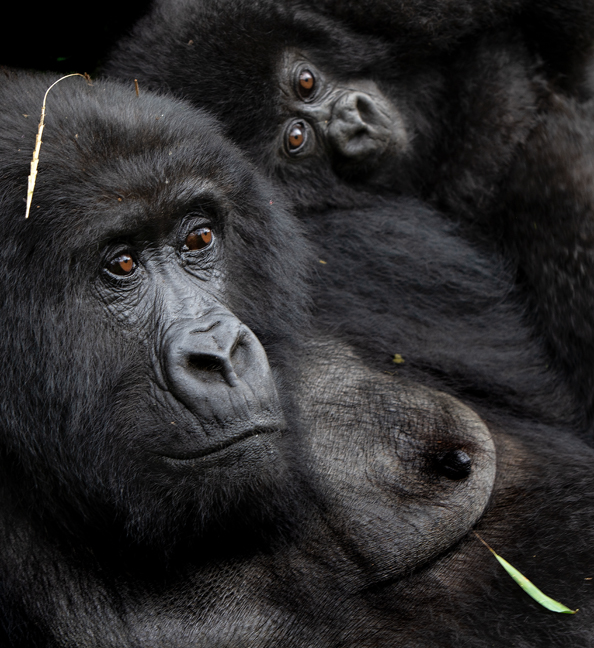

Volcanoes National Park, Ruhergeri, Rwanda, December 2019
We spent our first three mornings in Volcanoes National Park in Ruhergeri, Rwanda. The first with the Muhoza Family of Mountain Gorillas, the newest group in the Park. It was formed by Muhoza, the dominant Silverback on December 3, 2016, when he grabbed two females from the Hirwa Family Group. He is the youngest dominant Silverback in the Park and one of the largest, weighing more than 460 pounds.
We spent the second morning with Golden Monkeys, the other endangered primate in the Park. There are less than 3,000 Golden Monkeys left in the Park and their populations continue to dwindle.
We spent the third morning with the Agash Family Group of Mountain Gorillas. The group has been together under his leadership since 2010 and is comprised of more than 25 members, including three other Silverbacks, six adult females, four immature male blackbacks, two sub-adult females, three juveniles and six infants.
All of the treks in Park are held in the early morning and are limited to a one-hour interaction. Each gorilla group is visited no more than once per day with each group limited to eight tourists, guides, trackers and porters.
Whereas Golden Monkeys are often high in the trees, interactions with Mountain Gorillas are personal and often within a few yards as they are habituated and often pass in close proximity. At times, you have to quickly move out of the way. They are imposing, though not frightening and difficult to photograph.
There is limited light due to the heavy jungle cover and their deep inset brown eyes rarely capture the light, an essential ingredient for successful Mountain Gorilla photographs. There are also seven other tourists trying to take pictures and many pushing the limits to get effective iPhone images.
©Rich Beckman
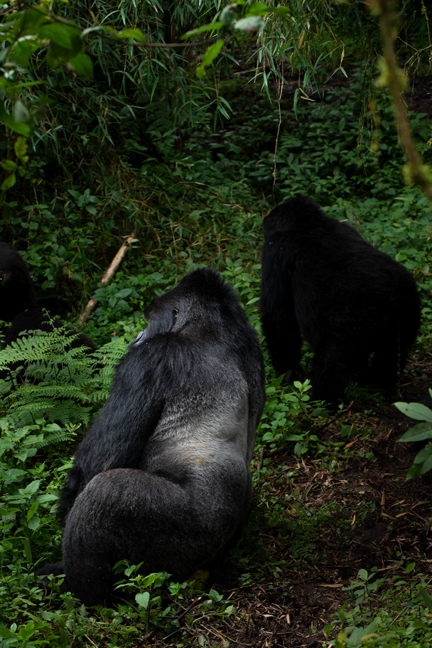

Volcanoes National Park, Ruhergeri, Rwanda, December 2019
We spent our first three mornings in Volcanoes National Park in Ruhergeri, Rwanda. The first with the Muhoza Family of Mountain Gorillas, the newest group in the Park. It was formed by Muhoza, the dominant Silverback on December 3, 2016, when he grabbed two females from the Hirwa Family Group. He is the youngest dominant Silverback in the Park and one of the largest, weighing more than 460 pounds.
We spent the second morning with Golden Monkeys, the other endangered primate in the Park. There are less than 3,000 Golden Monkeys left in the Park and their populations continue to dwindle.
We spent the third morning with the Agash Family Group of Mountain Gorillas. The group has been together under his leadership since 2010 and is comprised of more than 25 members, including three other Silverbacks, six adult females, four immature male blackbacks, two sub-adult females, three juveniles and six infants.
All of the treks in Park are held in the early morning and are limited to a one-hour interaction. Each gorilla group is visited no more than once per day with each group limited to eight tourists, guides, trackers and porters.
Whereas Golden Monkeys are often high in the trees, interactions with Mountain Gorillas are personal and often within a few yards as they are habituated and often pass in close proximity. At times, you have to quickly move out of the way. They are imposing, though not frightening and difficult to photograph.
There is limited light due to the heavy jungle cover and their deep inset brown eyes rarely capture the light, an essential ingredient for successful Mountain Gorilla photographs. There are also seven other tourists trying to take pictures and many pushing the limits to get effective iPhone images.
©Rich Beckman
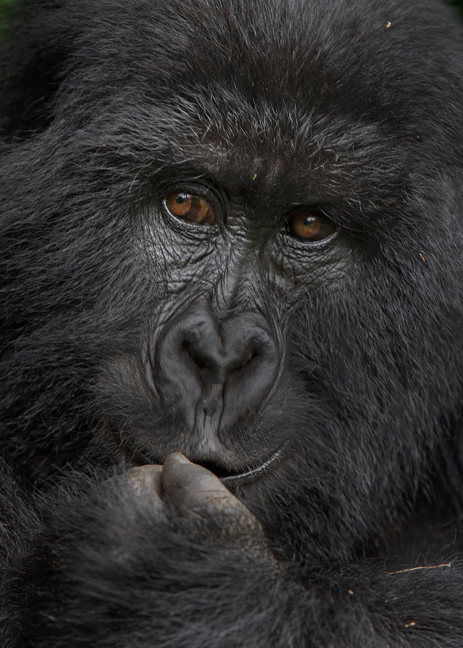

Volcanoes National Park, Ruhergeri, Rwanda, December 2019
We spent our first three mornings in Volcanoes National Park in Ruhergeri, Rwanda. The first with the Muhoza Family of Mountain Gorillas, the newest group in the Park. It was formed by Muhoza, the dominant Silverback on December 3, 2016, when he grabbed two females from the Hirwa Family Group. He is the youngest dominant Silverback in the Park and one of the largest, weighing more than 460 pounds.
We spent the second morning with Golden Monkeys, the other endangered primate in the Park. There are less than 3,000 Golden Monkeys left in the Park and their populations continue to dwindle.
We spent the third morning with the Agash Family Group of Mountain Gorillas. The group has been together under his leadership since 2010 and is comprised of more than 25 members, including three other Silverbacks, six adult females, four immature male blackbacks, two sub-adult females, three juveniles and six infants.
All of the treks in Park are held in the early morning and are limited to a one-hour interaction. Each gorilla group is visited no more than once per day with each group limited to eight tourists, guides, trackers and porters.
Whereas Golden Monkeys are often high in the trees, interactions with Mountain Gorillas are personal and often within a few yards as they are habituated and often pass in close proximity. At times, you have to quickly move out of the way. They are imposing, though not frightening and difficult to photograph.
There is limited light due to the heavy jungle cover and their deep inset brown eyes rarely capture the light, an essential ingredient for successful Mountain Gorilla photographs. There are also seven other tourists trying to take pictures and many pushing the limits to get effective iPhone images.
©Rich Beckman
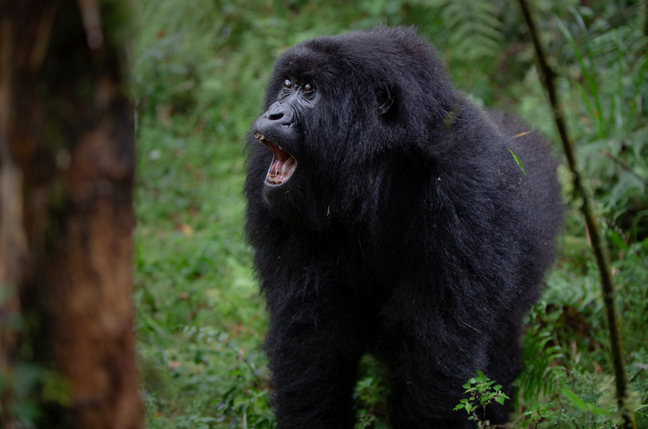

Volcanoes National Park, Ruhergeri, Rwanda, December 2019
We spent our first three mornings in Volcanoes National Park in Ruhergeri, Rwanda. The first with the Muhoza Family of Mountain Gorillas, the newest group in the Park. It was formed by Muhoza, the dominant Silverback on December 3, 2016, when he grabbed two females from the Hirwa Family Group. He is the youngest dominant Silverback in the Park and one of the largest, weighing more than 460 pounds.
We spent the second morning with Golden Monkeys, the other endangered primate in the Park. There are less than 3,000 Golden Monkeys left in the Park and their populations continue to dwindle.
We spent the third morning with the Agash Family Group of Mountain Gorillas. The group has been together under his leadership since 2010 and is comprised of more than 25 members, including three other Silverbacks, six adult females, four immature male blackbacks, two sub-adult females, three juveniles and six infants.
All of the treks in Park are held in the early morning and are limited to a one-hour interaction. Each gorilla group is visited no more than once per day with each group limited to eight tourists, guides, trackers and porters.
Whereas Golden Monkeys are often high in the trees, interactions with Mountain Gorillas are personal and often within a few yards as they are habituated and often pass in close proximity. At times, you have to quickly move out of the way. They are imposing, though not frightening and difficult to photograph.
There is limited light due to the heavy jungle cover and their deep inset brown eyes rarely capture the light, an essential ingredient for successful Mountain Gorilla photographs. There are also seven other tourists trying to take pictures and many pushing the limits to get effective iPhone images.
©Rich Beckman
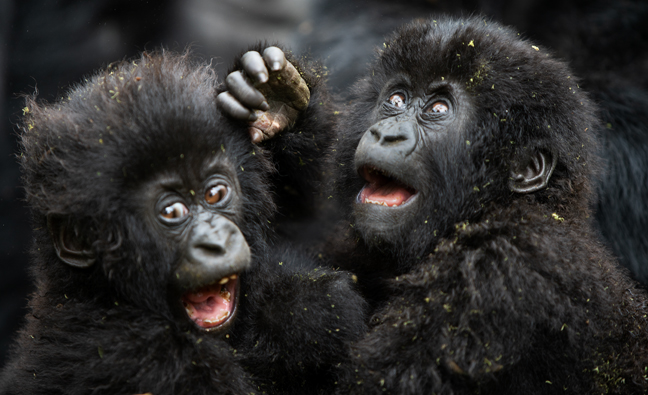

Volcanoes National Park, Ruhergeri, Rwanda, December 2019
We spent our first three mornings in Volcanoes National Park in Ruhergeri, Rwanda. The first with the Muhoza Family of Mountain Gorillas, the newest group in the Park. It was formed by Muhoza, the dominant Silverback on December 3, 2016, when he grabbed two females from the Hirwa Family Group. He is the youngest dominant Silverback in the Park and one of the largest, weighing more than 460 pounds.
We spent the second morning with Golden Monkeys, the other endangered primate in the Park. There are less than 3,000 Golden Monkeys left in the Park and their populations continue to dwindle.
We spent the third morning with the Agash Family Group of Mountain Gorillas. The group has been together under his leadership since 2010 and is comprised of more than 25 members, including three other Silverbacks, six adult females, four immature male blackbacks, two sub-adult females, three juveniles and six infants.
All of the treks in Park are held in the early morning and are limited to a one-hour interaction. Each gorilla group is visited no more than once per day with each group limited to eight tourists, guides, trackers and porters.
Whereas Golden Monkeys are often high in the trees, interactions with Mountain Gorillas are personal and often within a few yards as they are habituated and often pass in close proximity. At times, you have to quickly move out of the way. They are imposing, though not frightening and difficult to photograph.
There is limited light due to the heavy jungle cover and their deep inset brown eyes rarely capture the light, an essential ingredient for successful Mountain Gorilla photographs. There are also seven other tourists trying to take pictures and many pushing the limits to get effective iPhone images.
©Rich Beckman

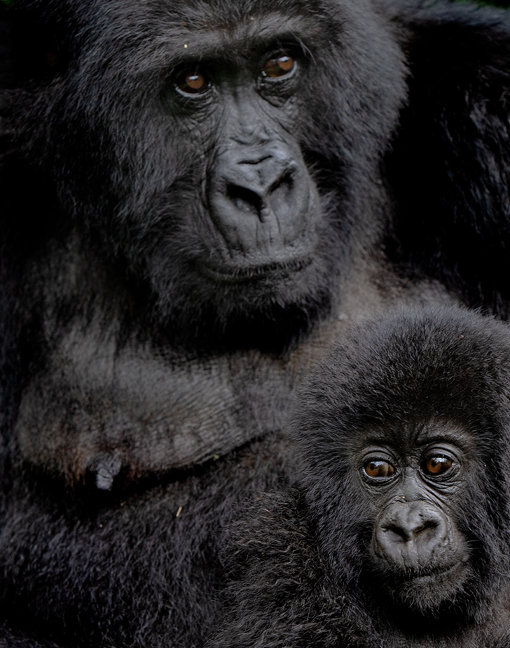
Volcanoes National Park, Ruhergeri, Rwanda, December 2019
We spent our first three mornings in Volcanoes National Park in Ruhergeri, Rwanda. The first with the Muhoza Family of Mountain Gorillas, the newest group in the Park. It was formed by Muhoza, the dominant Silverback on December 3, 2016, when he grabbed two females from the Hirwa Family Group. He is the youngest dominant Silverback in the Park and one of the largest, weighing more than 460 pounds.
We spent the second morning with Golden Monkeys, the other endangered primate in the Park. There are less than 3,000 Golden Monkeys left in the Park and their populations continue to dwindle.
We spent the third morning with the Agash Family Group of Mountain Gorillas. The group has been together under his leadership since 2010 and is comprised of more than 25 members, including three other Silverbacks, six adult females, four immature male blackbacks, two sub-adult females, three juveniles and six infants.
All of the treks in Park are held in the early morning and are limited to a one-hour interaction. Each gorilla group is visited no more than once per day with each group limited to eight tourists, guides, trackers and porters.
Whereas Golden Monkeys are often high in the trees, interactions with Mountain Gorillas are personal and often within a few yards as they are habituated and often pass in close proximity. At times, you have to quickly move out of the way. They are imposing, though not frightening and difficult to photograph.
There is limited light due to the heavy jungle cover and their deep inset brown eyes rarely capture the light, an essential ingredient for successful Mountain Gorilla photographs. There are also seven other tourists trying to take pictures and many pushing the limits to get effective iPhone images.
©Rich Beckman
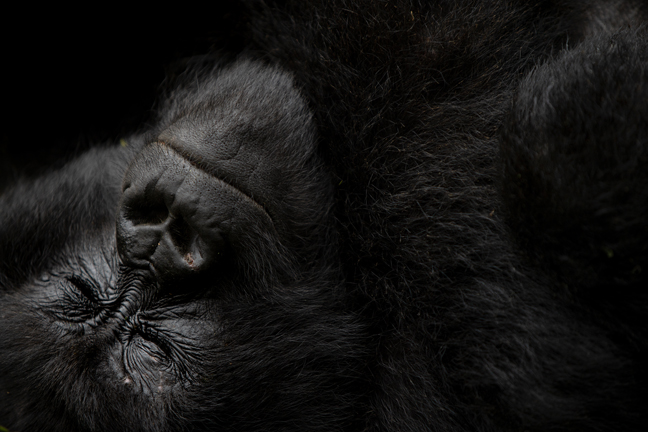

Volcanoes National Park, Ruhergeri, Rwanda, December 2019
We spent our first three mornings in Volcanoes National Park in Ruhergeri, Rwanda. The first with the Muhoza Family of Mountain Gorillas, the newest group in the Park. It was formed by Muhoza, the dominant Silverback on December 3, 2016, when he grabbed two females from the Hirwa Family Group. He is the youngest dominant Silverback in the Park and one of the largest, weighing more than 460 pounds.
We spent the second morning with Golden Monkeys, the other endangered primate in the Park. There are less than 3,000 Golden Monkeys left in the Park and their populations continue to dwindle.
We spent the third morning with the Agash Family Group of Mountain Gorillas. The group has been together under his leadership since 2010 and is comprised of more than 25 members, including three other Silverbacks, six adult females, four immature male blackbacks, two sub-adult females, three juveniles and six infants.
All of the treks in Park are held in the early morning and are limited to a one-hour interaction. Each gorilla group is visited no more than once per day with each group limited to eight tourists, guides, trackers and porters.
Whereas Golden Monkeys are often high in the trees, interactions with Mountain Gorillas are personal and often within a few yards as they are habituated and often pass in close proximity. At times, you have to quickly move out of the way. They are imposing, though not frightening and difficult to photograph.
There is limited light due to the heavy jungle cover and their deep inset brown eyes rarely capture the light, an essential ingredient for successful Mountain Gorilla photographs. There are also seven other tourists trying to take pictures and many pushing the limits to get effective iPhone images.
©Rich Beckman
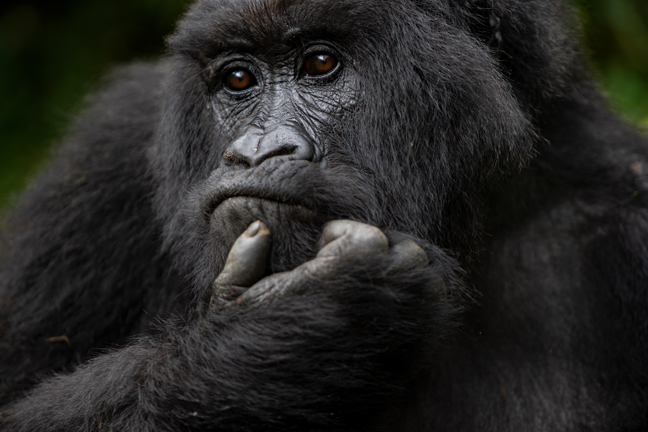

Volcanoes National Park, Ruhergeri, Rwanda, December 2019
We spent our first three mornings in Volcanoes National Park in Ruhergeri, Rwanda. The first with the Muhoza Family of Mountain Gorillas, the newest group in the Park. It was formed by Muhoza, the dominant Silverback on December 3, 2016, when he grabbed two females from the Hirwa Family Group. He is the youngest dominant Silverback in the Park and one of the largest, weighing more than 460 pounds.
We spent the second morning with Golden Monkeys, the other endangered primate in the Park. There are less than 3,000 Golden Monkeys left in the Park and their populations continue to dwindle.
We spent the third morning with the Agash Family Group of Mountain Gorillas. The group has been together under his leadership since 2010 and is comprised of more than 25 members, including three other Silverbacks, six adult females, four immature male blackbacks, two sub-adult females, three juveniles and six infants.
All of the treks in Park are held in the early morning and are limited to a one-hour interaction. Each gorilla group is visited no more than once per day with each group limited to eight tourists, guides, trackers and porters.
Whereas Golden Monkeys are often high in the trees, interactions with Mountain Gorillas are personal and often within a few yards as they are habituated and often pass in close proximity. At times, you have to quickly move out of the way. They are imposing, though not frightening and difficult to photograph.
There is limited light due to the heavy jungle cover and their deep inset brown eyes rarely capture the light, an essential ingredient for successful Mountain Gorilla photographs. There are also seven other tourists trying to take pictures and many pushing the limits to get effective iPhone images.
©Rich Beckman
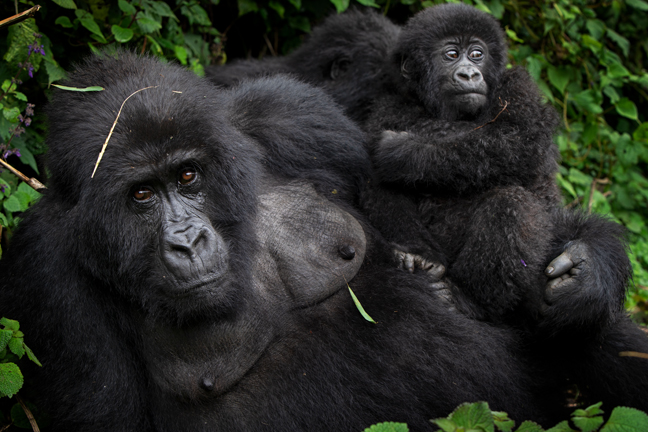

Volcanoes National Park, Ruhergeri, Rwanda, December 2019
We spent our first three mornings in Volcanoes National Park in Ruhergeri, Rwanda. The first with the Muhoza Family of Mountain Gorillas, the newest group in the Park. It was formed by Muhoza, the dominant Silverback on December 3, 2016, when he grabbed two females from the Hirwa Family Group. He is the youngest dominant Silverback in the Park and one of the largest, weighing more than 460 pounds.
We spent the second morning with Golden Monkeys, the other endangered primate in the Park. There are less than 3,000 Golden Monkeys left in the Park and their populations continue to dwindle.
We spent the third morning with the Agash Family Group of Mountain Gorillas. The group has been together under his leadership since 2010 and is comprised of more than 25 members, including three other Silverbacks, six adult females, four immature male blackbacks, two sub-adult females, three juveniles and six infants.
All of the treks in Park are held in the early morning and are limited to a one-hour interaction. Each gorilla group is visited no more than once per day with each group limited to eight tourists, guides, trackers and porters.
Whereas Golden Monkeys are often high in the trees, interactions with Mountain Gorillas are personal and often within a few yards as they are habituated and often pass in close proximity. At times, you have to quickly move out of the way. They are imposing, though not frightening and difficult to photograph.
There is limited light due to the heavy jungle cover and their deep inset brown eyes rarely capture the light, an essential ingredient for successful Mountain Gorilla photographs. There are also seven other tourists trying to take pictures and many pushing the limits to get effective iPhone images.
©Rich Beckman
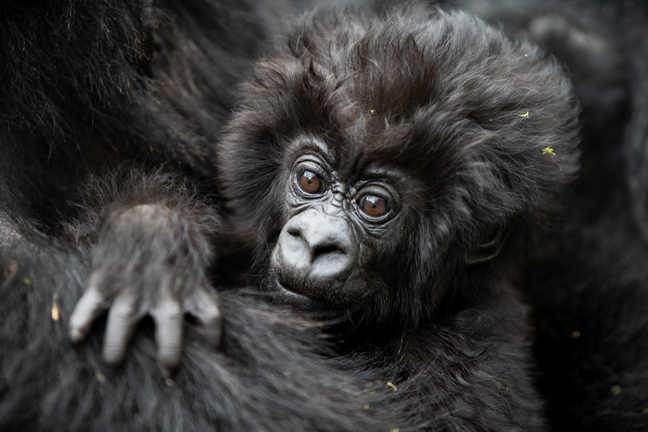

Volcanoes National Park, Ruhergeri, Rwanda, December 2019
We spent our first three mornings in Volcanoes National Park in Ruhergeri, Rwanda. The first with the Muhoza Family of Mountain Gorillas, the newest group in the Park. It was formed by Muhoza, the dominant Silverback on December 3, 2016, when he grabbed two females from the Hirwa Family Group. He is the youngest dominant Silverback in the Park and one of the largest, weighing more than 460 pounds.
We spent the second morning with Golden Monkeys, the other endangered primate in the Park. There are less than 3,000 Golden Monkeys left in the Park and their populations continue to dwindle.
We spent the third morning with the Agash Family Group of Mountain Gorillas. The group has been together under his leadership since 2010 and is comprised of more than 25 members, including three other Silverbacks, six adult females, four immature male blackbacks, two sub-adult females, three juveniles and six infants.
All of the treks in Park are held in the early morning and are limited to a one-hour interaction. Each gorilla group is visited no more than once per day with each group limited to eight tourists, guides, trackers and porters.
Whereas Golden Monkeys are often high in the trees, interactions with Mountain Gorillas are personal and often within a few yards as they are habituated and often pass in close proximity. At times, you have to quickly move out of the way. They are imposing, though not frightening and difficult to photograph.
There is limited light due to the heavy jungle cover and their deep inset brown eyes rarely capture the light, an essential ingredient for successful Mountain Gorilla photographs. There are also seven other tourists trying to take pictures and many pushing the limits to get effective iPhone images.
©Rich Beckman
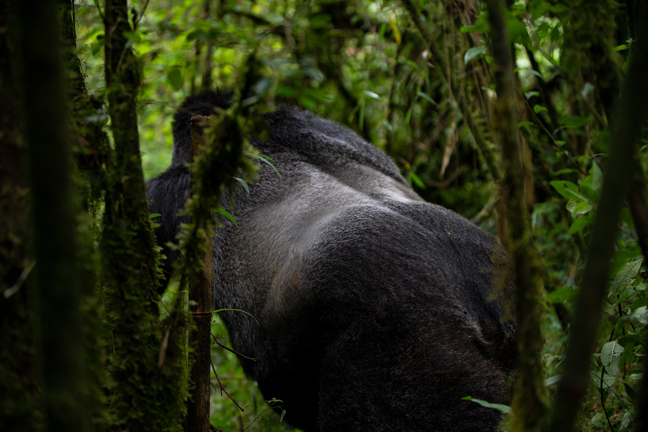

Volcanoes National Park, Ruhergeri, Rwanda, December 2019
We spent our first three mornings in Volcanoes National Park in Ruhergeri, Rwanda. The first with the Muhoza Family of Mountain Gorillas, the newest group in the Park. It was formed by Muhoza, the dominant Silverback on December 3, 2016, when he grabbed two females from the Hirwa Family Group. He is the youngest dominant Silverback in the Park and one of the largest, weighing more than 460 pounds.
We spent the second morning with Golden Monkeys, the other endangered primate in the Park. There are less than 3,000 Golden Monkeys left in the Park and their populations continue to dwindle.
We spent the third morning with the Agash Family Group of Mountain Gorillas. The group has been together under his leadership since 2010 and is comprised of more than 25 members, including three other Silverbacks, six adult females, four immature male blackbacks, two sub-adult females, three juveniles and six infants.
All of the treks in Park are held in the early morning and are limited to a one-hour interaction. Each gorilla group is visited no more than once per day with each group limited to eight tourists, guides, trackers and porters.
Whereas Golden Monkeys are often high in the trees, interactions with Mountain Gorillas are personal and often within a few yards as they are habituated and often pass in close proximity. At times, you have to quickly move out of the way. They are imposing, though not frightening and difficult to photograph.
There is limited light due to the heavy jungle cover and their deep inset brown eyes rarely capture the light, an essential ingredient for successful Mountain Gorilla photographs. There are also seven other tourists trying to take pictures and many pushing the limits to get effective iPhone images.
©Rich Beckman
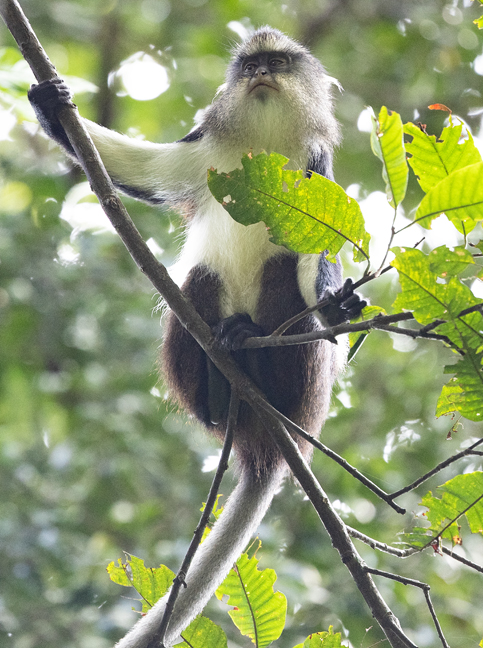

Mona Monkey, Nyungwe Forest National Park, Rusizi, Rwanda
We spent our last two mornings in Nyungwe Forest National Park in southwest Rwanda, partly abutting the Burundi border and within easy view of eastern DRC. Chimpanzees inhabit the Park as well as Colobus Monkeys. Our Chimpanzee trek was extremely challenging. It was a 90-minute drive on four-wheel drive roads to the trailhead and there is barely a trail. It required leaving the lodge at 4:45 a.m. for a long downhill muddy trek into the jungle with equal amounts of bushwhacking and trekking through thick vines. We saw very few Chimpanzees, and most were high in trees and backlit. The trek back was uphill on slick muddy terrain with the added pleasure of encountering ant colonies. Mixed in with the few Chimpanzees, also high in the trees were scattered Mona Monkeys.
We opted out of our second planned Chimpanzee trek scheduled for the following morning and instead spent a leisurely hour with Colobus Monkeys along an easily accessible trail in the Park.
©Rich Beckman
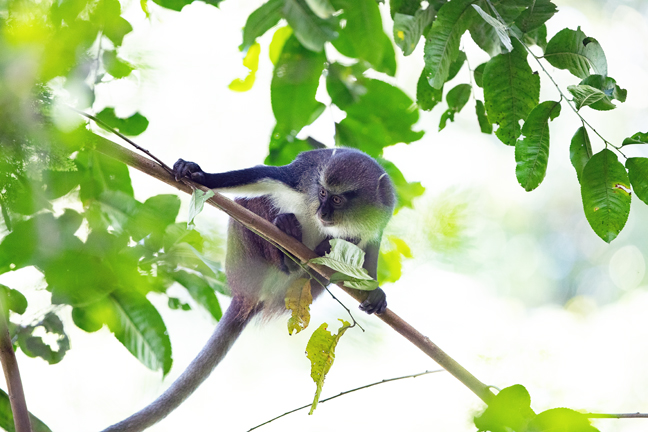

Mona Monkey, Nyungwe Forest National Park, Rusizi, Rwanda
We spent our last two mornings in Nyungwe Forest National Park in southwest Rwanda, partly abutting the Burundi border and within easy view of eastern DRC. Chimpanzees inhabit the Park as well as Colobus Monkeys. Our Chimpanzee trek was extremely challenging. It was a 90-minute drive on four-wheel drive roads to the trailhead and there is barely a trail. It required leaving the lodge at 4:45 a.m. for a long downhill muddy trek into the jungle with equal amounts of bushwhacking and trekking through thick vines. We saw very few Chimpanzees, and most were high in trees and backlit. The trek back was uphill on slick muddy terrain with the added pleasure of encountering ant colonies. Mixed in with the few Chimpanzees, also high in the trees were scattered Mona Monkeys.
We opted out of our second planned Chimpanzee trek scheduled for the following morning and instead spent a leisurely hour with Colobus Monkeys along an easily accessible trail in the Park.
©Rich Beckman
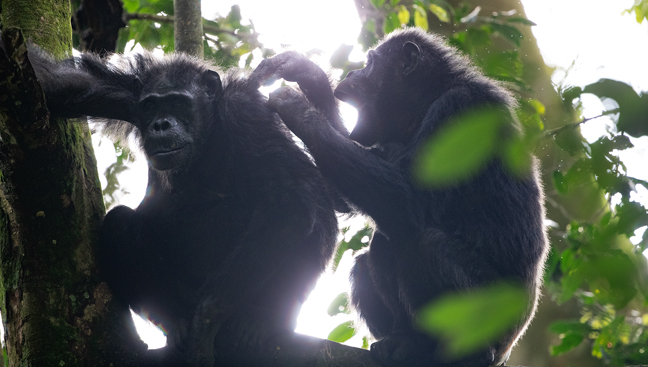

Chimpanzees, Nyungwe Forest National Park, Rusizi, Rwanda
We spent our last two mornings in Nyungwe Forest National Park in southwest Rwanda, partly abutting the Burundi border and within easy view of eastern DRC. Chimpanzees inhabit the Park as well as Colobus Monkeys. Our Chimpanzee trek was extremely challenging. It was a 90-minute drive on four-wheel drive roads to the trailhead and there is barely a trail. It required leaving the lodge at 4:45 a.m. for a long downhill muddy trek into the jungle with equal amounts of bushwhacking and trekking through thick vines. We saw very few Chimpanzees, and most were high in trees and backlit. The trek back was uphill on slick muddy terrain with the added pleasure of encountering ant colonies. Mixed in with the few Chimpanzees, also high in the trees were scattered Mona Monkeys.
We opted out of our second planned Chimpanzee trek scheduled for the following morning and instead spent a leisurely hour with Colobus Monkeys along an easily accessible trail in the Park.
©Rich Beckman
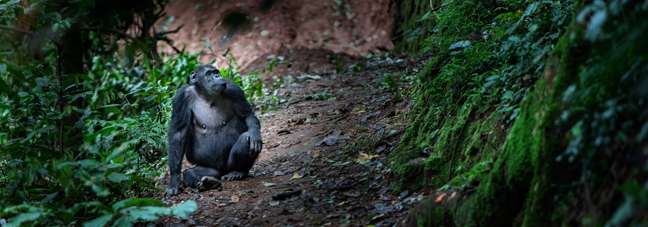

Chimpanzee, Nyungwe Forest National Park, Rusizi, Rwanda
We spent our last two mornings in Nyungwe Forest National Park in southwest Rwanda, partly abutting the Burundi border and within easy view of eastern DRC. Chimpanzees inhabit the Park as well as Colobus Monkeys. Our Chimpanzee trek was extremely challenging. It was a 90-minute drive on four-wheel drive roads to the trailhead and there is barely a trail. It required leaving the lodge at 4:45 a.m. for a long downhill muddy trek into the jungle with equal amounts of bushwhacking and trekking through thick vines. We saw very few Chimpanzees, and most were high in trees and backlit. The trek back was uphill on slick muddy terrain with the added pleasure of encountering ant colonies. Mixed in with the few Chimpanzees, also high in the trees were scattered Mona Monkeys.
We opted out of our second planned Chimpanzee trek scheduled for the following morning and instead spent a leisurely hour with Colobus Monkeys along an easily accessible trail in the Park.
©Rich Beckman
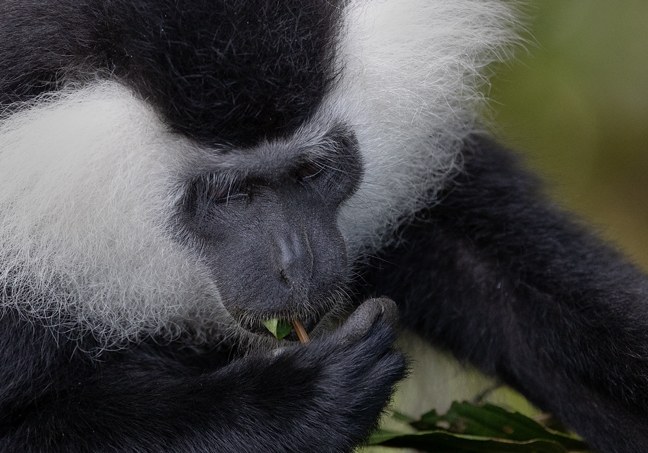

Colobus Monkeys, Nyungwe Forest National Park, Rusizi, Rwanda
We spent our last two mornings in Nyungwe Forest National Park in southwest Rwanda, partly abutting the Burundi border and within easy view of eastern DRC. Chimpanzees inhabit the Park as well as Colobus Monkeys. Our Chimpanzee trek was extremely challenging. It was a 90-minute drive on four-wheel drive roads to the trailhead and there is barely a trail. It required leaving the lodge at 4:45 a.m. for a long downhill muddy trek into the jungle with equal amounts of bushwhacking and trekking through thick vines. We saw very few Chimpanzees, and most were high in trees and backlit. The trek back was uphill on slick muddy terrain with the added pleasure of encountering ant colonies. Mixed in with the few Chimpanzees, also high in the trees were scattered Mona Monkeys.
We opted out of our second planned Chimpanzee trek scheduled for the following morning and instead spent a leisurely hour with Colobus Monkeys along an easily accessible trail in the Park.
©Rich Beckman
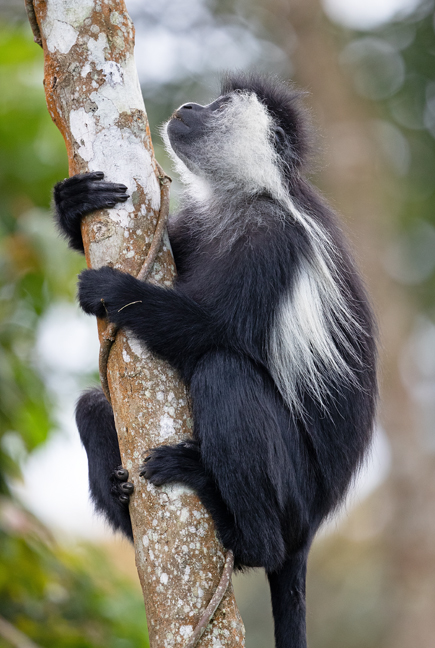

Colobus Monkey, Nyungwe Forest National Park, Rusizi, Rwanda
We spent our last two mornings in Nyungwe Forest National Park in southwest Rwanda, partly abutting the Burundi border and within easy view of eastern DRC. Chimpanzees inhabit the Park as well as Colobus Monkeys. Our Chimpanzee trek was extremely challenging. It was a 90-minute drive on four-wheel drive roads to the trailhead and there is barely a trail. It required leaving the lodge at 4:45 a.m. for a long downhill muddy trek into the jungle with equal amounts of bushwhacking and trekking through thick vines. We saw very few Chimpanzees, and most were high in trees and backlit. The trek back was uphill on slick muddy terrain with the added pleasure of encountering ant colonies. Mixed in with the few Chimpanzees, also high in the trees were scattered Mona Monkeys.
We opted out of our second planned Chimpanzee trek scheduled for the following morning and instead spent a leisurely hour with Colobus Monkeys along an easily accessible trail in the Park.
©Rich Beckman


Colobus Monkeys, Nyungwe Forest National Park, Rusizi, Rwanda
We spent our last two mornings in Nyungwe Forest National Park in southwest Rwanda, partly abutting the Burundi border and within easy view of eastern DRC. Chimpanzees inhabit the Park as well as Colobus Monkeys. Our Chimpanzee trek was extremely challenging. It was a 90-minute drive on four-wheel drive roads to the trailhead and there is barely a trail. It required leaving the lodge at 4:45 a.m. for a long downhill muddy trek into the jungle with equal amounts of bushwhacking and trekking through thick vines. We saw very few Chimpanzees, and most were high in trees and backlit. The trek back was uphill on slick muddy terrain with the added pleasure of encountering ant colonies. Mixed in with the few Chimpanzees, also high in the trees were scattered Mona Monkeys.
We opted out of our second planned Chimpanzee trek scheduled for the following morning and instead spent a leisurely hour with Colobus Monkeys along an easily accessible trail in the Park.
©Rich Beckman
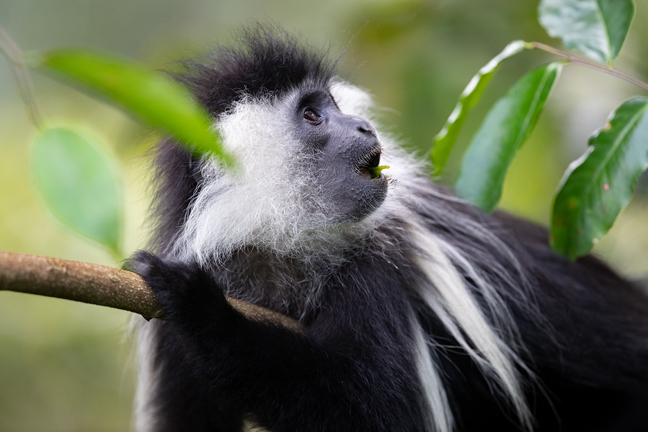

Colobus Monkey, Nyungwe Forest National Park, Rusizi, Rwanda
We spent our last two mornings in Nyungwe Forest National Park in southwest Rwanda, partly abutting the Burundi border and within easy view of eastern DRC. Chimpanzees inhabit the Park as well as Colobus Monkeys. Our Chimpanzee trek was extremely challenging. It was a 90-minute drive on four-wheel drive roads to the trailhead and there is barely a trail. It required leaving the lodge at 4:45 a.m. for a long downhill muddy trek into the jungle with equal amounts of bushwhacking and trekking through thick vines. We saw very few Chimpanzees, and most were high in trees and backlit. The trek back was uphill on slick muddy terrain with the added pleasure of encountering ant colonies. Mixed in with the few Chimpanzees, also high in the trees were scattered Mona Monkeys.
We opted out of our second planned Chimpanzee trek scheduled for the following morning and instead spent a leisurely hour with Colobus Monkeys along an easily accessible trail in the Park.
©Rich Beckman